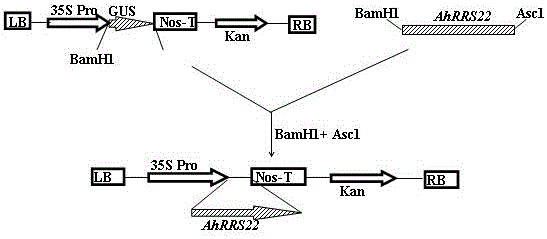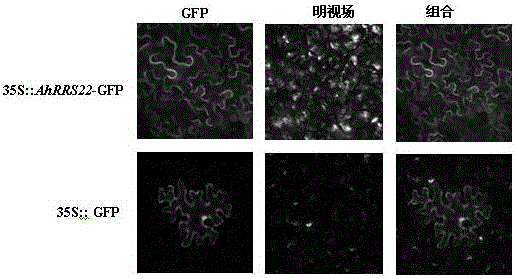Peanut ahrrs22 gene and its application in tobacco bacterial wilt resistance
A peanut and genetic technology, applied in the fields of application, genetic engineering, plant genetic improvement, etc., can solve the problem of unclear response mechanism of plant disease resistance, research on signal transduction pathways, research on the molecular mechanism of crop bacterial wilt resistance is in its infancy, etc. question
- Summary
- Abstract
- Description
- Claims
- Application Information
AI Technical Summary
Problems solved by technology
Method used
Image
Examples
Embodiment 1
[0018] [Example 1] RACE obtains 3' unknown sequence and 5' unknown sequence of AhRRS22 gene
[0019] Based on peanut abiotic and biotic stress 454 sequenced transcripts, the peanut expression profile gene chip (synthesized by Roche Company) was combined, and the candidate gene fragments were obtained by hybridization of the chip hybridization before and after inoculation of R. solanacearum strains before and after induction of R. solanacearum. Design a pair of gene primers PRRS_22_F (5'-TGAGGTTGTCTGATCAGAGCACAG-3') and PRRS_22-R (5'-GATCGAATAGTCTCCCCTGTAAGGT-3'); and then add the linker sequence RACE-F (AAGCAGTGGTATCAACGCAGAGTGGCCAT) and RACE-R (ATTCTAGAGGCCGAGGCGGCCGACATGd(T)30N-1N-3'), using PRRS_22-R primers and RACE-F primers and PRRS_22_F primers and RACE-R primers for 5' and 3'- RACE reactions, respectively, 5'- RACE reaction conditions are 94°C 5min→(94°C 30s→60°C 30s→72°C 2min) 30 cycles→72°C 10min; 3′-RACE reaction conditions are 94°C 5min→(94°C 30s→72°C 2min) 5cycles...
Embodiment 2
[0020] [Example 2] Construction and verification of AhRRS22 overexpression vector
[0021] AhRRS22 including the stop codon was amplified from a plasmid with a complete reading frame by the primers AhRRS22-OE-F (5'-ATTAGGATCCATGGCGGAAGCTTGGTTGTG-3') and AhRRS22-OE-R (5'-ATTTAGGCGCGCCTATCTAGCATCGATTAATTCCTTGAC-3') The cDNA open reading frame of the gene, with BamH1 and Asc1 restriction sites at the 5′ and 3′ ends, was used simultaneously for the pBI121-GUSA driven by the 2×CaMV 35S promoter constructed in our laboratory and the amplified AhRRS22 target fragment BamH1 (purchased from NEB Company) and Asc1 (purchased from NEB Company) were double digested, the target fragment was recovered, ligated with T4 ligase overnight at 16°C, transformed into E. coli DH5α strain, and p35S::AhRRS22-OE overexpression vector was constructed. After PCR verification and enzyme digestion verification, the correctness of the vector construction was confirmed. The vector diagram is as follows: fi...
Embodiment 3
[0022] [Example 3] Subcellular localization of AhRRS22 gene expression product
[0023]For subcellular localization vectors, amplify from a plasmid with a complete reading frame by primers AhRRS22-SL-F (5'-ATTAGGATCCATGGCGGAAGCTTGGTTGTG-3') and AhRRS22-SL-R (5'-ATTTAGGCGCGCCATCTAGCATCGATTAATTCCTTGAC-3') Obtain the cDNA of the AhRRS22 gene excluding the stop codon, with BamH1 and Asc1 restriction sites at the 5′ end and the 3′ end respectively. The pBI-GFP constructed in this laboratory and the amplified AhRRS22 gene were simultaneously digested with BamH1 and Asc1. , construct p35S::AhRRS22::GFP vector after ligation and transformation. Agrobacterium GV3101 was transformed by liquid nitrogen freeze-thaw method, and p35S::GFP was used as a control, and Agrobacterium infiltration method was used to transform Nicotiana benthamiana. After culturing at 25°C for 48 hours, the green fluorescence was observed with a fluorescence microscope (the wavelength of excitation light was 488nm...
PUM
 Login to View More
Login to View More Abstract
Description
Claims
Application Information
 Login to View More
Login to View More - R&D
- Intellectual Property
- Life Sciences
- Materials
- Tech Scout
- Unparalleled Data Quality
- Higher Quality Content
- 60% Fewer Hallucinations
Browse by: Latest US Patents, China's latest patents, Technical Efficacy Thesaurus, Application Domain, Technology Topic, Popular Technical Reports.
© 2025 PatSnap. All rights reserved.Legal|Privacy policy|Modern Slavery Act Transparency Statement|Sitemap|About US| Contact US: help@patsnap.com



